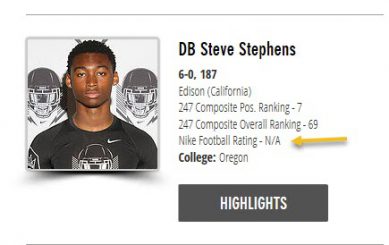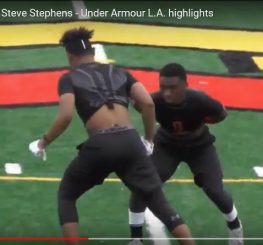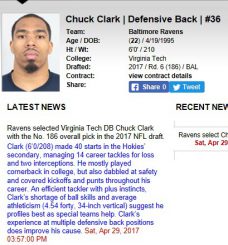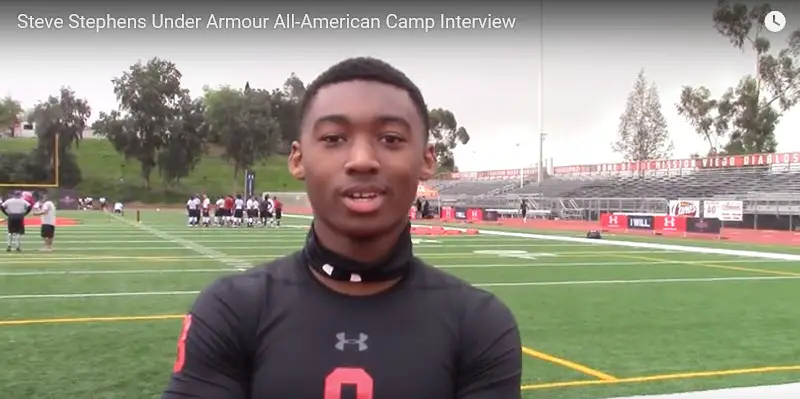The Oregon Ducks football team signed one of the best safety tandems in all of college football in 2018 recruiting cycle: Jevon Holland from Bishop O’Dowd High School in Oakland, California, and Steve Stephens from Edison High School in Fresno, California. Although both of these athletes are similar in size and athleticism, we’re going to focus on Stephens in this analysis.
Stephens was rated a top-150 player at any position (No. 115) by ESPN.com. He was also listed in the prestigious Tacoma News-Tribune “Western 100” as one of the top-100 players in the western United States. In addition, Stephens was a first-team defensive back on Cal-Hi Sports All-State Football Team.
A protégé of renowned DB guru Tony Perry at Edison High, Stephens capped a stellar career as a three-year starter at defensive back with a fine senior season in which he amassed 53 total tackles, one sack, four interceptions, and 15 pass break-ups, per MaxPreps.com. Mr. Perry, an icon in “The Valley” in Central California, who was credited with developing an impressive pedigree of defensive backs including Tim McDonald, T.J. McDonald, and Robert Golden, (as well as Stephens) passed away on November 11, 2017.
TRIANGLE NUMBERS
Stephens has nice size for a safety. He has been listed by various media sources as 6-feet tall and 185 pounds. On the low end, Rotoworld lists him at 6-feet tall and 170 pounds, while ESPN.com lists him at 6-feet tall and 187 pounds on the high end.
No information has been made available as to his arm legth or hand size. However, for similar sized athletes taken in the last two NFL Drafts, his arm length should be approximately 32″ long and his hand size right at 9-1/4″.

Steve Stephens – The Opening Roster
Stephens participated in The Opening presented by Nike, an annual showcase of the premier high school football players in the country. They are officially measured for height and weight and put through a battery of skills testing such as Speed, Power, Agility, Reaction, and Quickness (“SPARQ”). These grades are a general guide line to the student-athletes athleticism. An incomplete score indicates that the athlete was incapable of completing the testing due to injury, or that he chose not to do one or more of the drills. Stephens “N/A” indicates that he more than likely did not participate in all five testing events.
The recruiting website ESPN.com lists a partial testing results that we can only assume came from The Opening. His shuttle time is good, his vertical jump is excellent and his power-ball throw of 42 feet is elite. There is no apparent record of him testing in the all-important 40 yard dash, which is disappointing.
SKILL SET
Steve Stephens has nice size for a kid approaching his freshman year of college. He is all of 6-feet tall and approaching 190 pounds. A check of the last two NFL Drafts provides some perspective of where a still maturing Stephens stacks up. This information is from The Great Blue North for 2016 and 2017.

Steve Stephens – UA Highlights – L.A.
He is a tough, physical kid that thrives in “the box” near the line of scrimmage (LOS). He does a nice job of wrapping up when tackling. Stephens can sink his hips and change direction with fluidity. He demonstrates press coverage technique utilizing his great strength, especially in the slot and lined up in Cover 1 (a Base Defense against a Tight End). Stephens has the strength & length combination to be an effective strong safety at the collegiate level.
Tackling…
In the video above, Stephens drops his hips and fills the hole. A strong safety has to be a physical presence in the box, and Stephens shows he is more than capable.
How do you stop a big running back? You go low and wrap him up as Stephens demonstrates in the video above.
Range…
In the video above, Edison appears to be in Cover 0, with no deep safety. Stephens comes up and stops the Fly Sweep for a five-yard loss, demonstrating great range.
Press Coverage…
Stephens in press coverage. He flashes a nice hand punch and some quick twitch on this play, tools that will have his college coaches, Keith Heyward and Donte Williams, salivating.
Deep Cover Responsibilities…
In the play above, Stephens recovers well after initially getting beat on a skinny post. He has the confidence to turn his back and then re-acquire the football, closing on the receiver to make the play.
As the above video demonstrates, Stephens has been an impact player since his sophomore year of high school. Here he high-points the ball on an interception, and demonstrates some big play ability early in his high school career.
Ball Skills…are shaky
This video above sheds some light on one skillset that may be a problem area. Stephens does not appear to be a natural pass catcher. A receiver or defensive back that is comfortable catching passes will snatch the ball out of the air away from their body. They don’t “fight” the ball on the way in. Stephens appears to struggle somewhat with this.
Who He Reminds Me Of…

Chuck Clark – Baltimore Ravens
Chuck Clark of the Baltimore Ravens. Clark was taken in the sixth round (No. 186 overall) of the 2017 NFL Draft from Virginia Tech. He and Steve Stephens share similar size and talent. Both are primarily forces against the run, and have issues at the back end in coverage. Clark is a “situational” guy used in packages against the run where he can play to his strengths.
Other players that are similar for comparison are Jonathan “Rudy” Ford of the Arizona Cardinals, also taken in the sixth round (No. 208 overall) of last year’s draft, and Michael Tyson of the Seattle Seahawks taken in the same draft (No. 187 overall) out of the University of Cincinnati.
ASSESSMENT
Steve Stephens should enjoy a solid career at Oregon if used in a manner that plays to his strengths. He is a classic “box” strong safety who is comfortable up close to the line of scrimmage, or in press coverage against a slot receiver (particularly a tight end). He plays with power and is an aggressive tackler that wraps up and gets his man on the ground.
In pass defense he demonstrates nice range, and plays with his head on a swivel. He can track and highpoint the football at a high level. However, he appears to “fight” the ball at times. A natural pass catcher snatches the ball out of the air away from his body, and puts it away cleanly with a fluid motion. There are film clips of Stephens demonstrating that he struggles with this.

Steve Stephens – Oregon Commit
Furthermore, there are legitimate questions concerning his speed. The lack of an official “clock” on him, coupled with what is evidenced on film, leads me to believe that his 40-yard dash time is over 4.70. At a position that is speed-critical, it is unlikely that he plays beyond college. All of the guys that I compared him to above are late round NFL picks, and they all ran the 40 in the 4.50 to 4.55 range, which is the bare minimum for today’s pass-happy NFL. A 4.70 (or higher) will not even get you a tryout in the league. Indeed, for the 2017 NFL Draft, only five of the top 20 safeties ran over 4.55, and all of those five ranked in the bottom half of that group.
Stephens will be a solid situational package guy at Oregon; used on first downs and short yardage areas of the field. He will be an asset in the Red Zone, where there isn’t much green behind him. He should also be a solid special teams contributor throughout his career. He is a good football player, and if the coaching staff plays him to his strengths and does not expose him to situations that do not suit his skillset well, he should have a productive career in Eugene.
Michael Kelly “ChicoDuck”
Chico, California
Top Photo Credit: YouTube Interview with Ryan Wright
For more Talent Evaluations, click here.
The NFL draft has always fascinated me in that I find it interesting how GM’s build their teams, and I joined eDuck (15 years ago) and became interested in the college & high school evaluations. I have doing it on that website for at least ten years.
I played high school ball at Cottage Grove in the early ‘70’s, and actually played at Autzen a few times back when they let the local high schools play there on Friday nights. (I also ran track at Hayward field too) I’m a life-long Duck fan and Green Bay Packers fan (and Shareholder).

